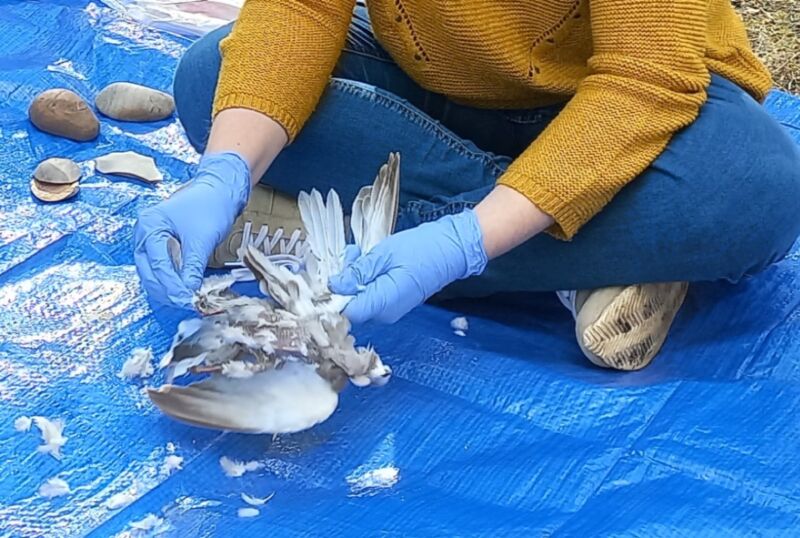
Mariana Nabais
Archaeologists interested in learning more about how Neanderthals prepared and cooked their food conducted a series of hands-on experiments on small poultry using flint flakes to carve them. They found that the flint flakes were surprisingly effective at carving birds, according to their new paper published in the journal Frontiers in Environmental Archaeology. They also concluded that cooking birds damaged the bones so badly that they were unlikely to be preserved in the archaeological record.
According to the authors, Neanderthals were able to survive for over 200,000 years in a wide range of geographic regions. Archaeologists are naturally interested in how they provided for themselves. Research has been conducted into how they killed and hunted large game. Neanderthals were expert hunters, known for killing bears and other carnivores. A pair of Middle Paleolithic lion fibulae found in eastern Iberia, bearing cut marks, indicate that the lion was skinned, while other lion bones found in southwestern France around the same time showed cut marks indicating flaying.
And as we reported last year, researchers have found evidence of what may be the earliest known example of lion hunting, based on an in-depth forensic analysis of a cave lion skeleton showing evidence of injury from a wooden spear around 48,000 years ago.
The team tested their hypothesis by reconstructing the ballistics of a wooden-tipped spear impacting the rib, matching the direction, angle of impact, and depth of penetration. Judging from these aspects, it appears that the spear passed through the left side of the cave lion’s abdomen and through vital organs before striking the right side of the rib. The same study also found cave lion claw bones showing evidence of flaying around 190,000 years ago.
However, small game animals like birds have received much less attention. Still, “birds provide a complementary food resource that may have played a critical role in Neanderthal adaptation and survival,” wrote co-author Mariana Nabais of the Institut Catala de Paleoecologia Humana i Evolucio Social in Spain, and her colleagues. So they designed a pilot study simulating early humans’ cooking and cutting methods to provide a baseline, compiling a database of telltale marks that could help archaeologists better analyze artifacts by comparing the marks on them to the database.
Birds roasted on an open fire
Nabais et al. collected specimens of frozen birds that had died under natural conditions in a wildlife reserve in Portugal, selecting species that would taxonomically represent those that Neanderthals would have likely hunted in the Iberian Peninsula: the carrion crow, the wood pigeon, and the collared turtle dove. All five specimens were plucked.
Two of these were cut raw, using a replica flint flake (made by the students) where necessary; the techniques used were drawn from archaeological evidence and ethnographic data. The scientists then cleaned and dried the bones, examining them under a microscope to look for cut marks, breaks and burns. They also analysed the flake for wear and found small scars on the crescent-shaped edge.
-
Wear on the chip used for butchery.
Marina Church
-
Bones recovered from birds.
Mariana Nabais
“Using a flake of flint to cut food required considerable precision and effort, which we were not fully aware of until this experiment,” Nabais said. “The flakes were sharper than we initially thought, requiring careful handling to make precise cuts without injuring our fingers. These hands-on experiments highlighted the practical challenges of Neanderthal food processing and cooking, providing a tangible link to their daily lives and survival strategies.”
The other three birds were roasted whole (without cuts) over hot coals at 500°C: first on their belly for four minutes, then turned and roasted for another three minutes. The team was careful to maintain a constant temperature and monitor the cooking time so as not to overcook the meat. “Perhaps because we plucked the birds before cooking, the roasting process was much quicker than expected,” Nabais said. “In fact, we spent more time preparing the coals than cooking them, which took less than ten minutes.”
The team also analyzed the bones of the cooked birds. In the first case, these bones were much more brittle—some were broken—and almost all had black or brown burns, as well as black spots inside the internal cavities of some bones. “Because burned bird bones are prone to breakage and loss, roasting activities may therefore go unnoticed in archaeological sites,” the authors write. “Such observations suggest that cooking methods significantly affect the preservation of skeletal remains in archaeological contexts, potentially influencing the archaeological visibility of certain culinary practices.”
Nabasi et al. pointed out that this was a pilot study with a very small sample size and limited species; the types of birds Neanderthals ate may have been more diverse. And despite their careful control of experimental conditions, it is simply not possible to exactly replicate Neanderthal methods, real-world conditions, and broader cultural contexts. They called for further research, expanding the experiments to more bird species and different cooking methods.
Frontiers in Environmental Archaeology, 2024. DOI: 10.3389/fearc.2024.1411853 (About DOIs).



